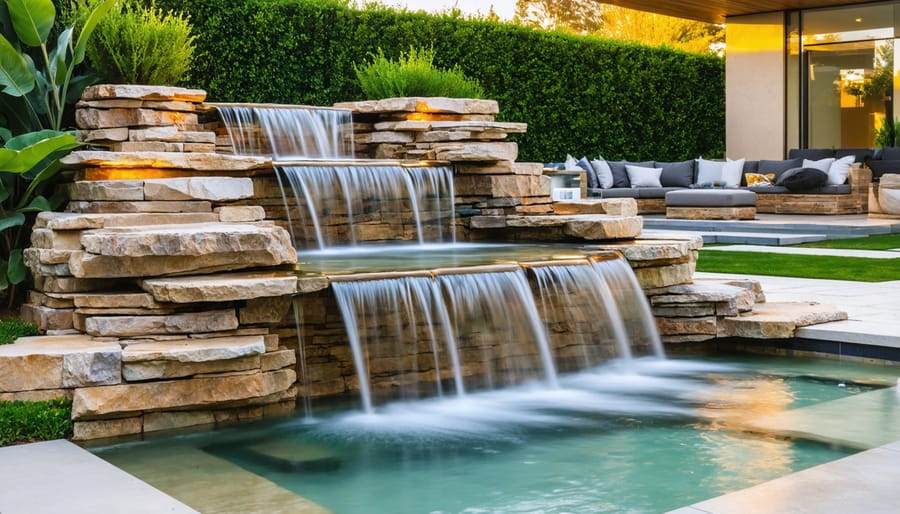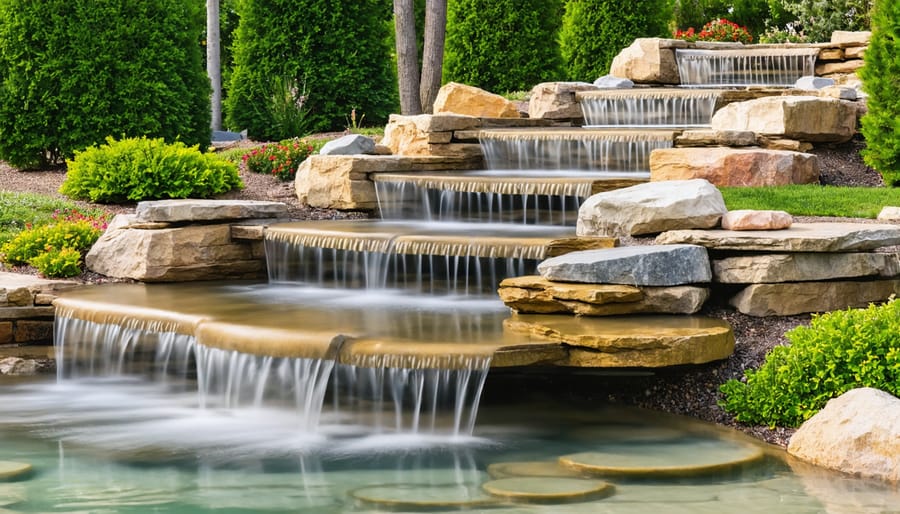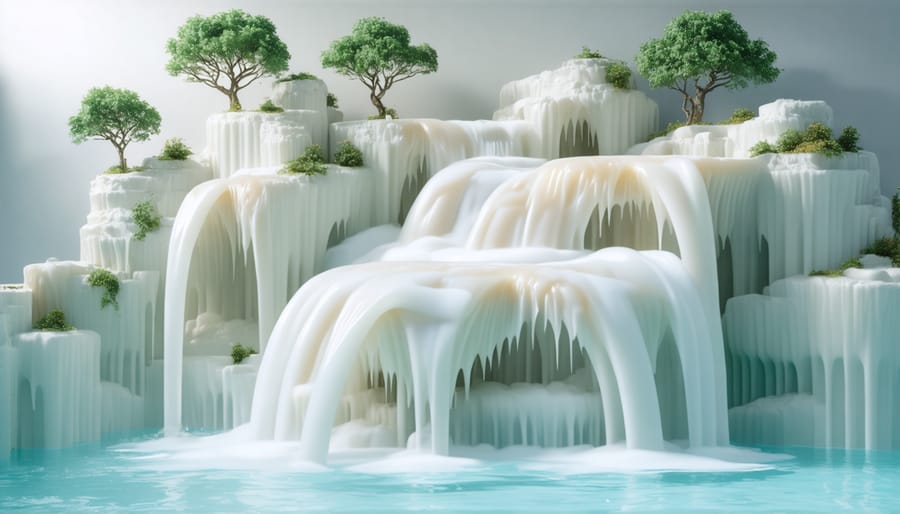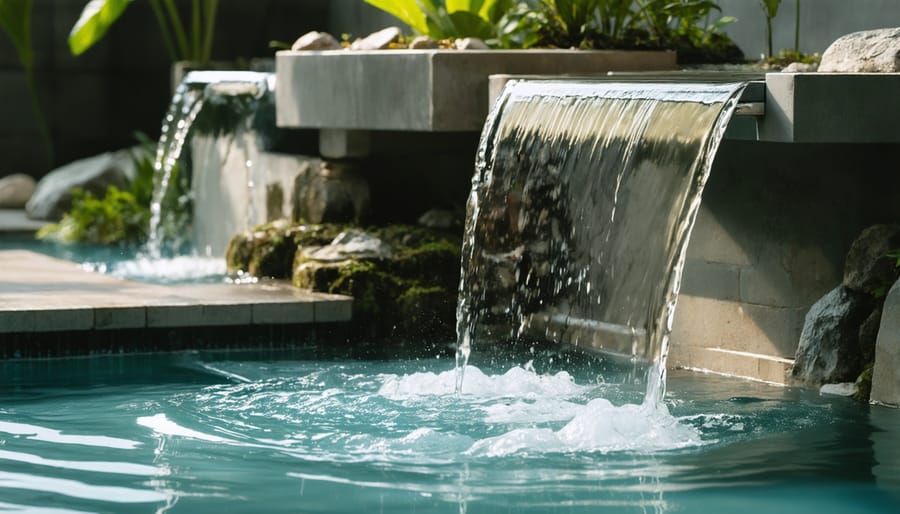Why Cascade Water Features Are Revolutionizing Backyard Spaces (And How to Add One Yourself)

Imagine water gracefully tumbling down stacked stone, creating that soothing soundtrack you’ve only heard at expensive resorts—that’s the magic of cascade water features. These multi-tiered fountains transform ordinary backyards into tranquil escapes by channeling water through a series of stepped pools or rocky ledges, mimicking nature’s own waterfalls. Unlike traditional single-spout fountains, cascades offer visual drama and superior sound quality, making them the centerpiece of any wellness retreat transformation.
What makes cascades particularly appealing for homeowners is their versatility. They solve practical problems like masking traffic noise, managing sloped terrain, and creating natural privacy screens—all while adding thousands to your property value. The stepped design means you’re not limited to flat yards; in fact, challenging landscapes become assets. Modern cascade kits have revolutionized installation, bringing what once required professional contractors within reach of confident DIYers. With pump technology advances and pre-formed components, you can achieve that luxury resort ambiance without the matching price tag, typically investing between $500 and $3,000 depending on scale and materials.
What Makes Cascade Water Features Different from Traditional Fountains
If you’ve ever watched water tumble over rocks in a stream, you’ve seen the magic that cascade water features bring to your backyard. Unlike traditional fountains that typically shoot water straight up in a single jet or spray pattern, cascade features create a stepped, flowing effect that mimics nature’s own waterfalls.
The key difference lies in the design. Traditional fountains often sit as standalone centerpieces with water recirculating through a central pump, creating vertical movement. Cascade water features, on the other hand, work horizontally across multiple tiers or levels. Water flows from one level to the next, creating that soothing, babbling brook sound that homeowners absolutely love. Think of it as bringing a miniature mountain stream right into your outdoor space.
This multi-level approach offers some real advantages. First, the cascading motion naturally aerates the water, which means better water quality if you’re incorporating plants or fish. Second, the flowing design integrates beautifully with sloped yards—actually turning a landscaping challenge into a stunning focal point. Many homeowners have shared that their cascade features helped solve drainage issues while adding visual appeal.
Another distinction is the natural aesthetic. While classic fountains can feel formal or ornamental, cascades blend seamlessly with rock gardens, native plantings, and rustic outdoor themes. You’re not limited to structured bowls or statuary. Instead, you can customize the look with natural stone, slate, or even modern materials that create contemporary stepped designs.
The cascading effect also distributes sound differently. Rather than a single splash point, you get gentle water sounds across multiple levels, creating ambient noise that masks traffic or neighborhood sounds more effectively than traditional fountain designs.

The Real Benefits You’ll Notice Immediately
Transforming Noise Pollution Into Peaceful Sounds
One of the most beloved benefits of cascade water features is their remarkable ability to create a natural sound barrier for your outdoor space. If you’ve ever felt frustrated by traffic noise, barking dogs, or neighborhood activity interrupting your backyard peace, cascading water offers an elegant solution.
The science behind this is simple yet effective. Moving water produces what’s called “white noise”—a consistent, pleasant sound that naturally masks unwanted disturbances. Unlike jarring interruptions, the gentle rushing of cascading water creates a calming audio backdrop that your brain perceives as soothing rather than distracting.
Many homeowners report immediate improvements in their outdoor experience. “We couldn’t enjoy our patio because of the busy street nearby,” shares Jennifer from Portland. “Once we installed our cascade feature, it was like flipping a switch. We actually hear the water instead of the traffic now.”
The multi-tiered design of cascade features amplifies this benefit—each level creates its own distinct water sound, layering gentle splashes and trickles that effectively drown out disturbances. This natural approach to soundscaping techniques transforms your yard into a peaceful retreat without artificial noise machines or expensive soundproofing.
Low-Maintenance Beauty That Works Year-Round
One of the biggest advantages of cascade water features is how little maintenance they actually require compared to traditional ponds or elaborate fountain systems. Unlike ponds, you won’t spend weekends battling algae blooms, testing water chemistry, or worrying about fish health. Cascade features use circulating water systems that stay cleaner naturally through constant movement, reducing stagnant areas where debris accumulates.
The seasonal maintenance is straightforward and manageable for most homeowners. During spring and summer, you’ll simply need to check the pump occasionally and remove any leaves or debris from the basin—typically a 15-minute task every few weeks. Many homeowners find this routine actually enjoyable, giving them a moment to appreciate their outdoor space. In fall, a quick clean-out before winter prevents buildup, and winterization usually involves draining the system and protecting the pump according to manufacturer guidelines.
Because cascade features have fewer components than complex fountain systems with multiple spray patterns and lighting elements, there are fewer things that can malfunction. The straightforward design means you’re not constantly troubleshooting intricate plumbing or replacing specialized parts. This simplicity translates to long-term cost savings and more time enjoying your feature rather than maintaining it.
Solving Sloped Yard Challenges
If you’ve got a sloped yard, you know the struggle—mowing on an angle, dealing with erosion, or watching topsoil wash away after every rainstorm. Rather than fighting against your terrain, a cascade water feature transforms that challenging slope into your yard’s most captivating element.
Cascade features are specifically designed to work *with* gravity, not against it. Each tier naturally channels water downward, creating visual interest at multiple levels while actually helping stabilize the soil beneath. The flowing water and strategic rock placement reduce erosion by slowing runoff and directing it where you want it to go.
Many homeowners discover this solution after years of frustration. “We used to dread that steep section near our patio,” shares Jennifer from Ohio. “Now our cascade is the first thing guests comment on. It completely changed how we use our backyard.”
The beauty is that what once seemed like a landscaping liability becomes your property’s signature feature. Those awkward elevation changes? They’re now creating the perfect drop heights for dramatic water movement. Installation even becomes simpler since you’re working with the natural grade rather than excavating flat ground.
Popular Cascade Water Feature Innovations Available Today
Modular Systems You Can Install Yourself
Good news for hands-on homeowners: you don’t need to hire a contractor to enjoy a beautiful cascade water feature in your yard. Pre-fabricated cascade kits have transformed what was once a complex project into a weekend DIY adventure that most people can tackle with confidence.
These modular systems typically arrive with everything you need in one package—pre-formed basins, spillways, pumps, tubing, and detailed instructions. The components are designed to stack and connect like building blocks, eliminating guesswork about water flow and placement. Many homeowners report completing installation in just 4-6 hours, even without prior experience.
Popular materials include durable resin that mimics natural stone, lightweight fiberglass, and genuine slate pieces. The beauty of these kits is their forgiving nature—if something doesn’t look quite right, you can easily adjust the positioning before securing everything in place.
Most systems require only basic tools you probably already own: a shovel, level, and utility knife. The pump simply plugs into a standard outdoor outlet, and many kits now include LED lighting that connects just as easily.
“I was nervous about installing ours, but the instructions were crystal clear,” shares homeowner Maria T. “By Sunday afternoon, we had water cascading beautifully down three tiers. It felt like such an accomplishment!”

Solar-Powered Options That Cut Energy Costs
Solar-powered cascade water features offer an incredibly practical solution for homeowners who want the beauty of flowing water without worrying about electrical wiring or sky-high utility bills. These innovative features use small solar panels to power the pump, meaning you can place them virtually anywhere in your yard that receives decent sunlight—no electrician required!
The cost savings are genuinely impressive. One homeowner in Arizona shared that her solar cascade fountain runs continuously during daylight hours without adding a penny to her electricity bill. The initial investment typically pays for itself within two years compared to electric models.
Modern solar pumps have come a long way, with many featuring battery backup systems that keep water flowing even on cloudy days or into the evening hours. This makes them reliable additions to your outdoor space. Installation is wonderfully straightforward—simply position your feature, angle the solar panel toward the sun, and enjoy. These solar outdoor power solutions are perfect for DIY enthusiasts who appreciate hassle-free setup.
The environmental benefits add another layer of satisfaction, reducing your carbon footprint while creating a peaceful backyard retreat.
Smart Features and LED Integration
Today’s cascade water features go far beyond simple pumps and tubing—they’re surprisingly smart! Modern systems now include app-controlled pumps that let you adjust water flow from your smartphone, whether you’re relaxing on your deck or away from home. Imagine turning your feature on just before guests arrive or scheduling it to run during your favorite outdoor dinner hours.
Programmable timers are a game-changer for busy homeowners. Set your cascade to operate during peak relaxation times while conserving energy during the day when you’re at work. Many homeowners report cutting their electricity costs by 40% simply by scheduling smarter operation times.
The real magic happens after sunset with integrated LED lighting. Just like smart outdoor lighting, modern cascade features use energy-efficient LEDs that transform your backyard into an enchanting evening retreat. Choose from color-changing options that shift with the seasons or stick with warm whites for timeless elegance.
One homeowner shared: “The LED lights made our cascade the centerpiece of evening gatherings. Our water bill barely changed, but the ambiance is priceless.”
Most smart features install with simple plug-and-play connections—no electrician needed. The investment typically adds $150-400 to your project but delivers years of convenience and visual appeal.
Choosing the Right Cascade Feature for Your Space
Size and Scale Considerations
Getting the proportions right makes all the difference between a stunning focal point and an awkward mismatch. Think of it this way: a six-foot cascade in a cozy 10×12 patio will dominate the space and feel overwhelming, while that same feature looks perfectly balanced in a sprawling half-acre yard.
For smaller spaces under 500 square feet, stick with compact designs around 2-3 feet tall. These work beautifully when viewed from 8-15 feet away, creating that soothing water sound without stealing the show from your seating area or plantings. Medium yards (500-1500 square feet) can handle features ranging from 3-5 feet, which remain visible from multiple vantage points without commanding all the attention.
Larger properties offer more flexibility, but even then, consider your primary viewing distance. Will you mostly see it from your deck twenty feet away, or up close while gardening? A helpful rule of thumb: your feature’s height should be roughly one-tenth of the viewing distance for balanced visual impact.
Before committing, use garden stakes and string to outline your planned dimensions. Live with this mockup for a few days, observing how it feels from different spots in your yard. This simple step prevents costly sizing mistakes and ensures your cascade enhances rather than overwhelms your outdoor space.
Material Options That Last
Choosing the right material for your cascade water feature directly impacts how long you’ll enjoy it and how much upkeep it requires. Let’s break down your options so you can make a confident decision.
**Resin composite** offers excellent value for most homeowners. It’s lightweight, resists cracking in cold weather, and mimics natural stone surprisingly well. The downside? It can fade after years of direct sunlight, though quality brands include UV protection that extends its life considerably.
**Natural stone** delivers unmatched authenticity and durability—many homeowners report their slate or granite features looking beautiful after a decade. However, it’s heavy (plan for reinforced support), expensive, and porous stones may develop algae staining without regular sealing.
**Metal options** like copper or stainless steel create stunning modern aesthetics. Copper develops that gorgeous patina over time, while stainless steel stays sleek indefinitely. Watch out for cheaper metals that rust or corrode when constantly exposed to water.
**Ceramic and glazed pottery** work beautifully for smaller features on patios or decks. They’re easy to clean and come in gorgeous colors, but they’re fragile—not ideal if you have active kids or pets nearby, and they’ll crack in freezing temperatures unless winterized properly.
Matching Your Home’s Style
Your cascade water feature should feel like a natural extension of your home, not an afterthought. For modern homes with clean lines and minimalist aesthetics, consider sleek stainless steel or concrete cascades with geometric shapes and simple water flows. These contemporary designs complement angular architecture beautifully.
If you’re working with a traditional or cottage-style home, natural stone cascades with irregular edges create that timeless appeal. Stack flat river rocks or flagstone to echo classic masonry details you might already have in walkways or retaining walls.
Rustic properties shine with weathered boulders and informal water paths that mimic mountain streams. Let moss and small plants grow between stones for an authentic wilderness feel.
Before purchasing, take photos of your yard from multiple angles and consider how the cascade’s materials, colors, and scale will blend with existing landscaping. Many homeowners find success matching their cascade stone to their home’s foundation or existing hardscaping—this creates visual harmony that makes the feature look intentional rather than added.
Installation Tips for DIY Success
Site Preparation and Foundation Basics
Getting your cascade water feature off to the right start makes all the difference between years of enjoyment and frustrating repairs down the road. Think of foundation work as your feature’s insurance policy—it’s where you prevent future headaches.
Start by checking your site’s drainage. Water should flow away from the feature’s base, not toward it. A simple trick: pour a bucket of water and watch where it goes naturally. If water pools, you’ll need to adjust the grade or add drainage solutions before proceeding.
Level ground is non-negotiable. Even a slight tilt compounds as your feature rises, leading to uneven water flow and potential tipping. Use a quality level and take your time—this step can’t be rushed. For larger installations, consider a compacted gravel base topped with paver sand for stability.
One homeowner shared how skipping proper leveling meant rebuilding her entire feature after just one season. She noted, “Those extra two hours of prep would’ve saved me a weekend of frustration!”
For heavier features, a concrete pad provides the most reliable foundation. Allow it to cure fully before placing any components. Remember: a feature that settles or shifts won’t just look off—it can crack basins and damage pumps, turning your peaceful cascade into an expensive problem.
Pump Selection and Water Flow Management
Choosing the right pump doesn’t need to be complicated. Think of it like this: a gentle cascade needs less power than a dramatic waterfall. For most residential cascade features covering 3-5 tiers, a pump rated between 200-800 gallons per hour works beautifully.
Start by measuring your feature’s height—you’ll need roughly 100 GPH for every foot of lift. A homeowner in Colorado shared that she initially chose an oversized pump, creating more splash than serenity. After switching to a smaller model with an adjustable flow valve, she found her perfect balance.
Here’s a practical tip: opt for pumps with flow adjustment controls. These let you fine-tune the water movement seasonally—a stronger flow keeps things moving in cooler weather, while a gentler cascade creates soothing sounds during peaceful summer evenings. Most quality pumps also include foam pre-filters that catch debris before it causes problems, saving you maintenance headaches down the road.

Avoiding Common First-Timer Mistakes
First-time installers often struggle with three key issues. **Electrical safety** tops the list—always use GFCI-protected outlets and waterproof connections rated for outdoor use. Don’t risk shortcuts here. **Reservoir sizing** catches many off-guard; your basin needs to hold at least twice the visible water volume to prevent pump burnout during operation. Finally, **splash control** becomes obvious only after you’ve soaked your patio! Position rocks strategically to redirect water flow, and consider adding splash guards or adjusting pump pressure. One homeowner shared: “I thought bigger meant better with my pump, but turning it down 30% eliminated splashing completely.” Test your feature thoroughly before finalizing rock placement, and keep extra sealant handy for unexpected leaks.
Keeping Your Cascade Feature Running Smoothly
Seasonal Care and Winterization
Protecting your cascade water feature from freezing temperatures doesn’t require professional help—just a few simple steps before winter arrives. Start by disconnecting and draining the pump completely, then store it indoors where it won’t freeze. Remove any debris from the basin and channels, as organic matter can cause staining during cold months. If you have fish or plants, relocate them to appropriate winter homes.
For the feature itself, you have two options: drain it completely and cover it with a waterproof tarp, or use a floating de-icer if you prefer keeping some water in the basin. Many homeowners find that covering their features protects against cracking and weather damage.
Come spring, inspect all components for cracks or damage before refilling. Clean surfaces thoroughly, reconnect your pump, and start with fresh water. One homeowner shared that taking photos during winterization helped her remember exactly how everything connected when spring arrived—a practical tip worth following! Your cascade will be bubbling beautifully again within an afternoon.
Quick Weekly Checks That Prevent Problems
Keeping your cascade water feature in peak condition doesn’t require hours of work—just a few minutes weekly can prevent headaches down the road. Start by checking the water level each week, especially during hot weather when evaporation accelerates. Low water can strain your pump and lead to expensive burnout.
Next, quickly remove any leaves, twigs, or debris from the surface and basins. This simple task prevents clogs that reduce flow and create stagnant water issues. One homeowner shared how a five-minute debris check saved her from a $200 pump replacement!
Take a moment to inspect your pump for unusual sounds or vibrations. A healthy pump runs smoothly and quietly. If you notice grinding noises or reduced water flow, addressing it immediately is much cheaper than waiting for complete failure.
Finally, wipe down visible surfaces to prevent mineral buildup and algae growth. These quick checks become second nature and ensure your beautiful cascade feature continues bringing tranquility to your outdoor space year after year.
Cascade water features offer more than visual appeal—they solve real challenges homeowners face, from masking unwanted neighborhood noise to transforming awkward slopes into stunning focal points. Whether you’re drawn to the soothing ambiance or seeking a practical solution for drainage issues, these outdoor innovations deliver results that elevate your entire property.
Ready to take the next step? If you’re handy with DIY projects, many cascade kits make installation surprisingly straightforward with clear instructions and weekend-friendly timelines. Prefer a professional touch? Consulting with a landscaping expert ensures your vision becomes reality while avoiding common pitfalls.
As you plan your cascade feature, don’t overlook the practical side of maintenance. You’ll need space for pumps, filters, cleaning supplies, and winterization equipment. A nearby shed provides the perfect solution for keeping everything organized and protected from the elements. Consider seasonal storage solutions that keep your water feature accessories accessible when needed and tucked away when not in use.
Transform your backyard into the peaceful retreat you’ve always imagined—one where the gentle cascade of water creates an atmosphere that welcomes you home every single day.

